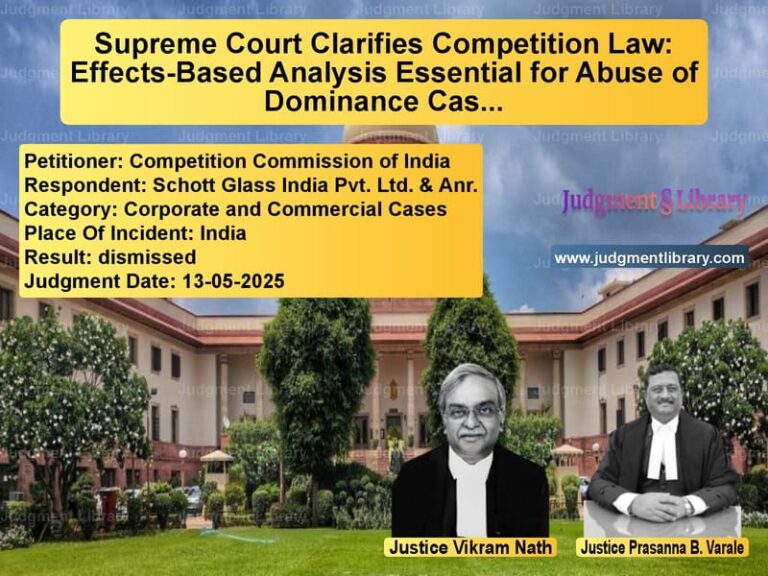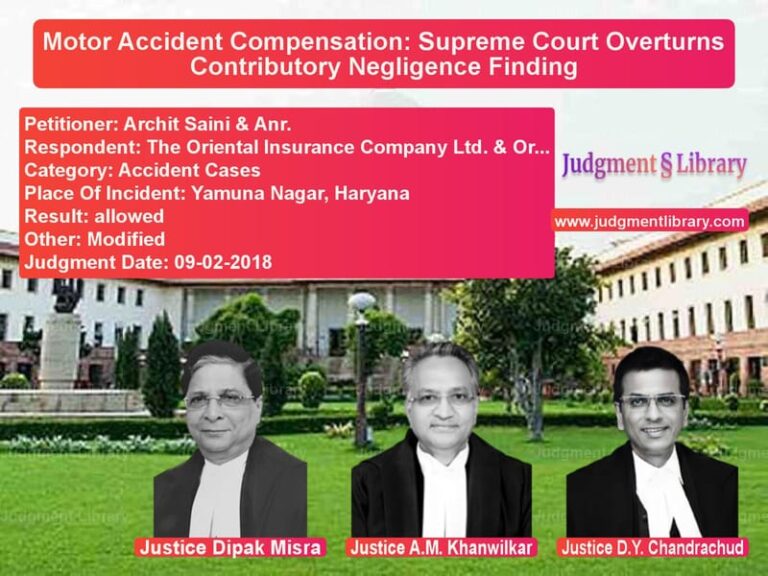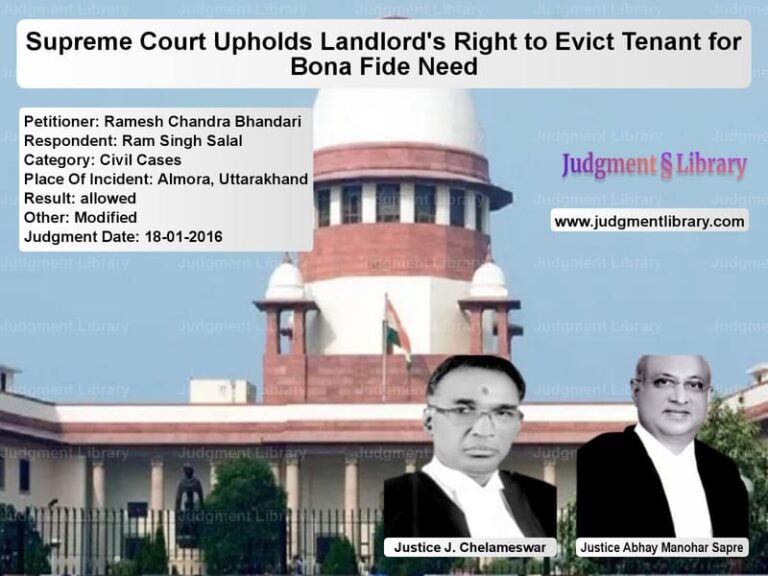Land Compensation Case: Supreme Court Increases Compensation for Acquired Land
The Supreme Court of India, in the case of Rajalakshmi vs. The Special Tahsildar (LA) Koyilandy & Another, ruled on the issue of fair compensation for land acquired by the government. The case revolved around the compensation awarded for land acquired in Kozhikode, Kerala, for the development of an IT Park.
The Court increased the compensation from ₹1,35,000 per cent, as determined by the Kerala High Court, to ₹1,60,000 per cent, considering the location, land type, and market valuation. The ruling ensures that landowners receive fair and just compensation when their property is acquired for public projects.
Background of the Case
The case involved land acquisition under the Land Acquisition Act, 1894. The government acquired land in Kozhikode for setting up an IT Park, and notifications under Section 4 of the Act were issued on August 21, 2009.
The compensation initially awarded by the Land Acquisition Officer was:
- ₹16,294 per cent for wetland
- ₹27,807 per cent for garden land without road access
- ₹45,897 per cent for garden land with road access
Landowners challenged the compensation before the Reference Court, which increased the amount to:
- ₹2,00,000 per cent for garden land adjacent to roads
- ₹1,75,000 per cent for garden land without road access
The High Court, however, reduced the compensation to ₹1,35,000 per cent, considering the negotiated price of other acquired lands.
Key Legal Issues
1. Whether the High Court erred in reducing the compensation from ₹2,00,000 per cent to ₹1,35,000 per cent.
2. Whether the compensation should be based on negotiated prices or market valuation.
3. Whether the Reference Court was correct in awarding a higher amount considering the land’s location and commercial potential.
Arguments Presented
Petitioners (Landowners) Arguments
- The land was garden land with road access, close to an upcoming IT Park, and deserved higher compensation.
- The High Court erred in relying on the negotiated price of ₹1,00,000 per cent, as some landowners might have accepted lower compensation under pressure.
- A sale exemplar showed land being sold for ₹4,00,000 per cent, which should have been considered as the market price.
- The High Court did not adequately account for the location advantage and future commercial value.
Respondents (Government and Acquiring Body) Arguments
- Most landowners accepted ₹1,00,000 per cent as compensation, so ₹1,35,000 per cent was already higher than the negotiated rate.
- The Reference Court had relied on incorrect valuation methods, leading to excessive compensation.
- The sale exemplar relied on by the landowners was for a commercial project and not suitable for comparison.
- Post-acquisition sales should not be considered for determining compensation.
Supreme Court’s Observations
The Supreme Court, led by Justices M.R. Shah and C.T. Ravikumar, made the following key observations:
- The compensation awarded by the High Court was on the lower side, given the location of the land.
- Garden lands with road access near an IT Park should receive higher compensation due to their commercial potential.
- While the sale exemplar for ₹4,00,000 per cent was discarded, a reasonable increase above ₹1,35,000 per cent was justified.
- Instead of a 35% increase over the negotiated price, a 60% increase was deemed fair, leading to ₹1,60,000 per cent as compensation.
Final Judgment
The Supreme Court ruled as follows:
- The compensation was increased from ₹1,35,000 per cent to ₹1,60,000 per cent.
- The landowners were entitled to all statutory benefits, including interest on the enhanced compensation.
- The acquiring body was directed to deposit the enhanced amount within six weeks.
Implications of the Judgment
The ruling has significant implications for land acquisition cases:
- Fairer Compensation for Landowners: The judgment ensures landowners are adequately compensated for their land.
- Precedent for Future Cases: Courts may use this ruling to award fair compensation in similar cases.
- Encouraging Equitable Settlements: Government bodies must negotiate fair compensation rather than relying on low initial offers.
Conclusion
The Supreme Court’s ruling in Rajalakshmi vs. The Special Tahsildar (LA) Koyilandy & Another reinforces the principle that landowners must receive just compensation when their property is acquired for public purposes. By increasing the compensation to ₹1,60,000 per cent, the Court has ensured that landowners are not shortchanged, considering the commercial potential and strategic location of the acquired land.
This judgment serves as an important precedent for future land acquisition disputes, balancing the interests of development projects with the rights of affected landowners.
Petitioner Name: Rajalakshmi.Respondent Name: The Special Tahsildar (LA) Koyilandy & Another.Judgment By: Justice M.R. Shah, Justice C.T. Ravikumar.Place Of Incident: Kozhikode, Kerala.Judgment Date: 10-04-2023.
Don’t miss out on the full details! Download the complete judgment in PDF format below and gain valuable insights instantly!
Download Judgment: rajalakshmi-vs-the-special-tahsilda-supreme-court-of-india-judgment-dated-10-04-2023.pdf
Directly Download Judgment: Directly download this Judgment
See all petitions in Property Disputes
See all petitions in Damages and Compensation
See all petitions in Landlord-Tenant Disputes
See all petitions in Judgment by Mukeshkumar Rasikbhai Shah
See all petitions in Judgment by C.T. Ravikumar
See all petitions in partially allowed
See all petitions in Modified
See all petitions in supreme court of India judgments April 2023
See all petitions in 2023 judgments
See all posts in Civil Cases Category
See all allowed petitions in Civil Cases Category
See all Dismissed petitions in Civil Cases Category
See all partially allowed petitions in Civil Cases Category







